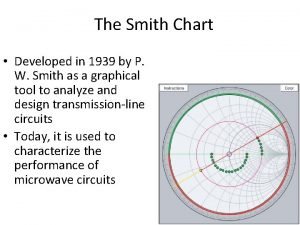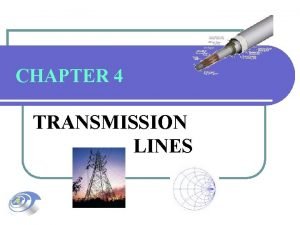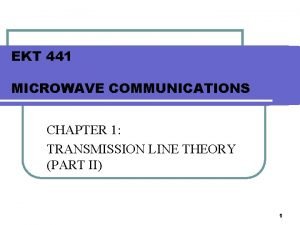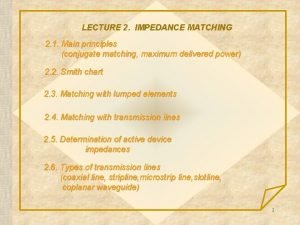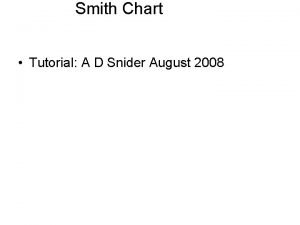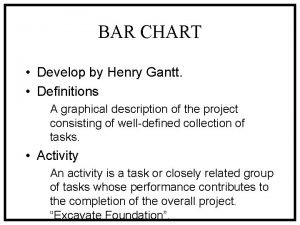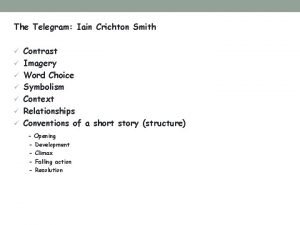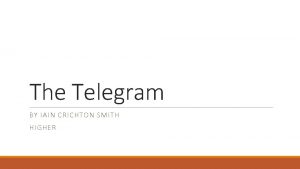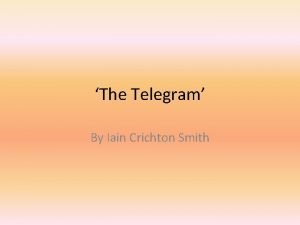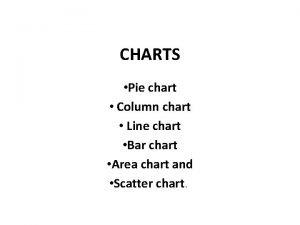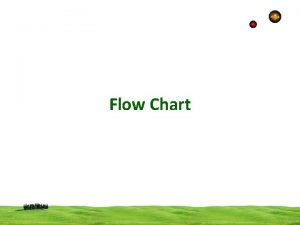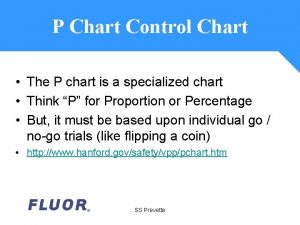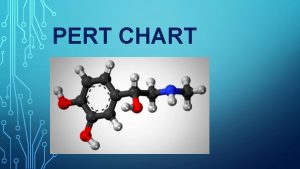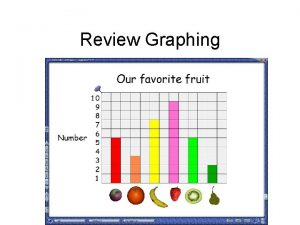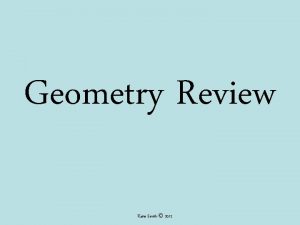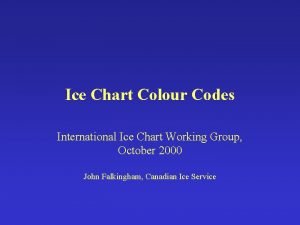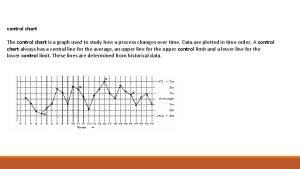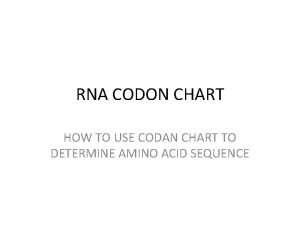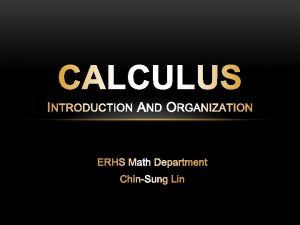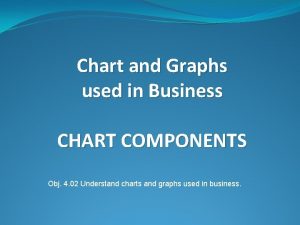Smith Chart Smith Chart Review j X 90

































- Slides: 33


Smith Chart

Smith Chart Review . +j. X 90 o Polar plane 1. 0. 8. 6 0 ¥ +R . 4 + 180 o - 0 -j. X . 2 0 o ¥ Rectilinear impedance plane -90 o Constant X Z L = Zo Smith Chart maps rectilinear impedance plane onto polar plane G= 0 Z L = 0 (short) G= 1 Constant R ± 180 O Z L= G =1 (open) 0 O Smith Chart Network Analyzer Basics DJB 12/96 na_basic. pre

Circuits components

Smith Chart main points

From S parameters to impedance

IF BW and averaging Heterodyne detection scheme IF BW reduction Averaging Dynamic Range (definition)

Smoothing trace Smoothing (similar to video filtering) averages the formatted active channel data over a portion of the displayed trace. Smoothing computes each displayed data point based on one sweep only, using a moving average of several adjacent data points for the current sweep. The smoothing aperture is a percent of the swept stimulus span, up to a maximum of 20%. Rather than lowering the noise floor, smoothing finds the mid-value of the data. Use it to reduce relatively small peak-to-peak noise values on broadband measured data. Use a sufficiently high number of display points to avoid misleading results. Do not use smoothing for measurements of high resonance devices or other devices with wide trace variations, as it will introduce errors into the measurement.

Averaging trace Averaging computes each data point based on an exponential average of consecutive sweeps weighted by a user-specified averaging factor. Each new sweep is averaged into the trace until the total number of sweeps is equal to the averaging factor, for a fully averaged trace. Each point on the trace is the vector sum of the current trace data and the data from the previous sweep. A high averaging factor gives the best signal-to-noise ratio, but slows the trace update time. Doubling the averaging factor reduces the noise by 3 d. B.

IF BW reduction IF bandwidth reduction lowers the noise floor by digitally reducing the receiver input bandwidth. It works in all ratio and non-ratio modes. It has an advantage over averaging as it reliably filters out unwanted responses such as spurs, odd harmonics, higher frequency spectral noise, and line-related noise. Sweep-to-sweep averaging, however, is better at filtering out very low frequency noise. A tenfold reduction in IF bandwidth lowers the measurement noise floor by about 10 d. B. Bandwidths less than 300 Hz provide better harmonic rejection than higher bandwidths.

Impedance Measurements

Which Value Do We Measure? TRUE EFFECTIVE INDICATED +/- % Instrument H Test fixture Real world device Kobe Instrument Division Back to Basics - LCRZ Module

Frequency vs. Measurement Techniques Network Analysis 100 KHz RF I-V 1 MHz 1. 8 GHz I-V 10 KHz 110 MHz Resonant 22 KHz 30 MHz 70 MHz Auto Balancing Bridge 5 HZ 1 40 MHz 10 100 1 K 100 K 1 M 100 M 1 G 10 G Frequency (Hz) H Kobe Instrument Division Back to Basics - LCRZ Module

Auto Balancing Bridge Theory of Operation Virtual ground H R 2 L DUT I V 1 I 2 I = I 2 + V 2 = I 2 R 2 Z= H V 1 I 2 V 2 = V 1 R 2 V 2 Kobe Instrument Division Back to Basics - LCRZ Module

Auto Balancing Bridge Advantages and Disadvantages Most accurate, basic accuracy 0. 05% Widest measurement range C, L, D, Q, R, X, G, B, Z, Y, O, . . . Widest range of electrical test conditions Simple-to-use Low frequency, f < 40 MHz H

Resonance (Q - Meter) Technique Theory of Operation Tune C so the circuit resonates At resonance XD = -XC , only RD remains DUT L (XD ), RD OSC I= e Z ~ e Tuning C (X c) V V R V XC = V = D (at resonance) I e Q= H |XD| |XC| |V| = = e RD RD Kobe Instrument Division Back to Basics - LCRZ Module

Resonant Method Advantages and Disadvantages Very good for high Q - low D measurements Requires reference coil for capacitors Limited L, C values accuracy Vector 75 k. Hz - 30 MHz automatic and fast easy to use limited compensation H Scalar 22 k. Hz - 70 MHz manual and slow requires experienced user No compensation

I - V Probe Technique Theory of Operation R 2 V 2 = I 2 R 2 V 1 I 2 DUT H V 2 Z= V 1 I 2 = V 1 R 2 V 2 Kobe Instrument Division Back to Basics - LCRZ Module

I-V (Probe) Advantages and Disadvantages Medium frequency, 10 k. Hz < f < 110 MHz Moderate accuracy and measurement range Grounded and in-circuit measurements Simple-to-use H

RF I-V Theory of Operation High Impedance Test Head Voltage Detection Vi Current Detection Ro Vv H Ro Low Impedance Test Head Vi Current Detection Voltage Detection Ro DUT Vv Ro DUT Kobe Instrument Division Back to Basics - LCRZ Module

RF I-V Advantages and Disadvantages High frequency, 1 MHz < f < 1. 8 GHz Most accurate method at > 100 MHz Grounded device measurement H

Network Analysis (Reflection) Technique Theory of Operation V INC DUT VR = H VR V INC = ZL- Z O ZL + Z O Kobe Instrument Division Back to Basics - LCRZ Module

Network Analysis Advantages and Disadvantages High frequency - Suitable, f > 100 k. Hz - Best, f > 1. 8 GHz Moderate accuracy Limited impedance measurement range (DUT should be around 50 ohms) H

TDR Theory of Operation Oscilloscope V INC DUT VR Z L Series R & L Step Generator = VR V INC = Parallel R & C Z L- Z O Z L+ Z O t 0 H H Kobe Instrument Division Back to Basics - LCRZ Module

TDNA (TDR) Advantages and Disadvantages Reflection and transmission measurements Single and multiple discontinuities or impedance mismatches ("Inside" look at devices) DUT impedance should be around 50 ohms Not accurate for m or M DUTs or with multiple reflections Good for test fixture design, transmission lines, high frequency evaluations H

Measurement examples

1 n. F 1 m. H 10 n. F 10 m. H 1 k. Ohm Corto circuito

1 n. F 1 m. H 10 n. F 10 m. H 1 k. Ohm Corto circuito

RF Device Characterization

Group delay

Deviation from Linear Phase Use electrical delay to remove linear portion of phase response + Frequency Low resolution Deviation from linear phase o (Electrical delay function) o Phase 45 /Div RF filter response Phase 1 /Div Linear electrical length added yields Frequency High resolution Network Analyzer Basics DJB 12/96 na_basic. pre

What is group delay? Frequency w tg Group Delay Dw Phase Group Delay to f Df Group Delay (t g) Average Delay = = f w f f -d f dw -1 360 o Frequency * df df Deviation from constant group delay indicates distortion in radians/sec Average delay indicates transit time in degrees in Hz ( w = 2 p f ) Network Analyzer Basics DJB 12/96 na_basic. pre

Phase Why measure group delay? f f -d f dw Group Delay -d f dw f f Same p-p phase ripple can result in different group delay Network Analyzer Basics DJB 12/96 na_basic. pre
 Chapter review motion part a vocabulary review answer key
Chapter review motion part a vocabulary review answer key Writ of certiorari ap gov example
Writ of certiorari ap gov example Narrative review vs systematic review
Narrative review vs systematic review Search strategy example
Search strategy example Narrative review vs systematic review
Narrative review vs systematic review Smith chart parametric equations
Smith chart parametric equations Quarter wave transformer smith chart
Quarter wave transformer smith chart Quarter wave transformer
Quarter wave transformer High resolution smith chart
High resolution smith chart Conjugate matching smith chart
Conjugate matching smith chart Smith chart tutorial
Smith chart tutorial Literature review gantt chart
Literature review gantt chart Talent management and succession planning toolkit
Talent management and succession planning toolkit Pie chart the great gatsby chapter 9 blame chart answers
Pie chart the great gatsby chapter 9 blame chart answers Henry gantt developed bar chart in
Henry gantt developed bar chart in Blue and green music
Blue and green music Smith conally act
Smith conally act Daniel craig homeless
Daniel craig homeless Betty smith williams
Betty smith williams The smith system is
The smith system is Economics from greek word
Economics from greek word Teoria del comercio internacional adam smith
Teoria del comercio internacional adam smith Paul ray smith
Paul ray smith Smith manoeuvre calculator
Smith manoeuvre calculator The telegram short story
The telegram short story The telegram short story
The telegram short story The telegram by iain crichton smith
The telegram by iain crichton smith The red door by iain crichton smith
The red door by iain crichton smith Professional learning focus
Professional learning focus Harris burdick pictures captain tory
Harris burdick pictures captain tory Uninvited guests harris burdick
Uninvited guests harris burdick Bessie smith harlem renaissance
Bessie smith harlem renaissance Teori ekonomi adam smith
Teori ekonomi adam smith Soraya smith
Soraya smith





